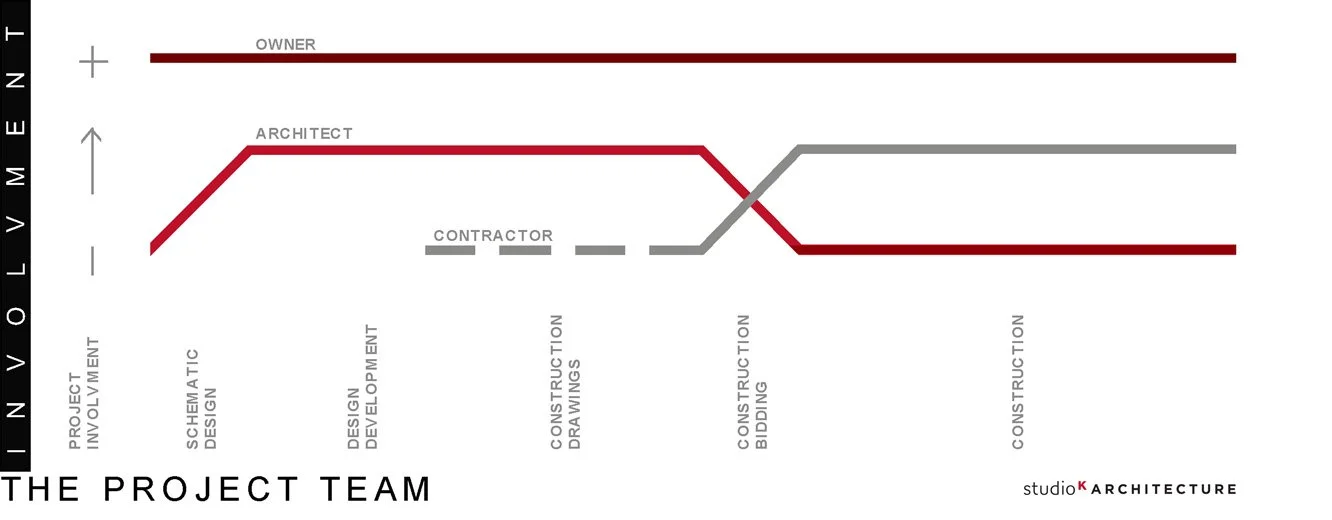
Working with an Architect
What to Expect
THE PROJECT TEAM – WHO’S WHO
Owner
The most important team member is the owner because without them, there is no project. The owner stays involved during the course of the project and is responsible for providing direction, approval and funding.
Architect
The architect is the team member responsible for translating the owner’s vision and program (wish list) into a design that can be built and used how the owner wishes. The architect uses drawings as a means to communicate the design to others. They coordinate and manage other design consultants such as structural, mechanical, electrical, plumbing and civil engineers. As the owner and architect work together to develop the design, the architect records design decisions on drawings that will ultimately be used to construct the project.
Contractor
This is the team member who will use the drawings and build the project. In some ways, the builder acts as the chef, using the recipes developed by the architect to prepare the meal. Like all good chefs, a good contractor infuses the project with a distinctive personality. This is done, not by altering the design, but by constructing the project with care and craftsmanship.
From beginning to end, the main players’ involvement in the project will vary with the one constant being the owner. The chart above graphically displays that the architect’s involvement in the project is intense during the design phase and then tapers off during construction. The opposite is true for the contractor, who’s involvement is minimal during design and maximum during construction.
Why Hire an Architect?
Architects are trained in the art and science of designing spaces to meet human requirements. They understand the relationship of space to human needs and can create harmony between interior and exterior and between new and existing spaces.
Understanding your Needs and Seeing the Big Picture:
An architect listens to you and transforms your needs and wishes into a tangible design that also complies with building and city codes and proper construction practices.
Solving Problems:
An architect can assist and guide you through the numerous design options, building codes, zoning laws, ADA compliance, life safety compliance, contractors, and permitting requirements for a successful project.
Better Design:
Architects can deliver a more interesting and creative design solution, with better relations to the site, a superior functioning floor plan often without adding significantly to the cost of construction, even sometimes saving you money.
Even the simplest projects can be very complex so Architects can make your life easier:
Every situation is different, including people, needs, site, financing, regulatory requirements, and others. Architects look out for your interests and find ways to make the process go smoothly and help you find qualified and reputable contractors and other team members. Architects furnish a complete set of drawings that specify materials in such detail as to allow several different contractors to submit competitive bids on a project.
Help avoid errors and construction conflicts which ultimately save you money:
Architects can help projects avoid construction conflicts and errors due to poor planning and coordination. Preparing accurate and detailed drawings significantly reduces design mistakes making the construction process smoother and more cost efficient. Well-conceived and designed projects can be built more efficiently and economically, providing savings for the owner. Changes to drawings are a lot less expensive than ones on the construction site.
Project Coordination:
During the design process you often times require services such as engineering and interior design. Also, as your agent during the construction phase of a project, the architect can help you evaluate the bids received and assist you in selecting a contractor. The architect can coordinate all of these professionals in order to keep drawings and ideas shared and consistent and to avoid conflicts.
Consistent Design Intent and Follow Through:
Construction projects are a lot of work. People make mistakes, existing conditions aren’t always what you expect, changes are inevitable no matter how much planning goes into a project. An architect can help catch mistakes made during construction and help problem solve when things don’t go as planned because they know the design and intent better than anyone else involved in the project. Architects can also help keep the design intent intact when problems arise or changes must be made.
The Five Phases of an Architectural Design Process
At studioK Architecture, we think it’s important to layout the process of working with us as clearly and succinctly as possible. That way you can gain an understanding of how we operate from the initial consultation all the way through construction administration. Ideally, we would prefer to work with you through every phase we describe below to ensure the smooth completion of your project – we carry out each phase with the intention of keeping your project on budget and within code. That being said, you may decide to contract with us to complete one or more phases separately, as you see fit. We discuss your options during the initial consultation meeting. The initial consultation will result in a proposal for our services as well as a breakdown of our fees. From there you’ll have the option to either sign the contract as-is or negotiate the particulars to your satisfaction. Once we have come to an agreement, we will begin Phase 1.
The duration of a project from start to finish can vary from a short period of time to lasting years depending on the projects complexity and scale, but in general the architectural design process is similar in all project sizes. The image above graphically displays the sequence of phases for a project along with the architects’ general breakdown of workload associated with each phase.
-
During this phase of the architectural design process, we will document any existing conditions through field studies and gather any relevant architectural data. Project feasibility, master planning, and programming of a project are developed as necessary to help define the project scope and end goals. We will use this information to create multiple design options for your consideration. We will generally present these options in the form of basic drawings and sketches, so you can visualize the different routes your project could take. You will also have the opportunity to further discuss any modifications you’d like us to make to your preferred design direction for your approval. To wrap up this phase, often times presentation quality materials are necessary to convey the project intent through basic floor plans and renderings to help others visualize the concept and to help with fundraising opportunities or other financing.
-
During the second phase, we will take the schematic design direction, as well as any requested modifications, and revise the design as necessary. Building programs and requirements will be confirmed and updated with the client along with the development of architectural character, details, and features. We take our clients’ budgets very seriously and continually strive to keep that budget in mind throughout the early stages of design. If you already have a contractor you would like to work with, this is a good time to provide them with a set of drawings to get a construction estimate. If you don’t, we can assist in completing an opinion of probable cost.
-
By now, we will have settled on a final design and will begin preparing drawings, notes, and technical specifications necessary for bidding, construction, and permit application. The final coordination with consultants such as engineers and interior designers happens during this time. This is the phase that many people think of when they picture the work of an architect – the creation of blueprints. Contractors will use these detailed drawings and specifications to prepare for the next phase in the architectural design process.
-
Having an architect on your side during the bidding phase of construction is of great advantage to you. At minimum, we can aid you in developing a list of qualified contractors for your bid list and submitting bid packages to bidders. But we can also review submitted bids, provide analysis, and help you compare the cost figures that you receive from your bidders. This phase will ensure the contractors you are considering for your construction project are reading the blueprints correctly and are providing an accurate bid for your project.
-
Finally, once you have selected a contractor and construction is under way, we move into the fifth phase of the architectural design process – construction administration. During this phase, we will administer the construction process to assure conformance with design intent, visit the site during construction, and address any field conditions as they arise. This final phase, along with all the others described above, will help ensure the smooth and satisfactory completion of your construction or renovation project.


